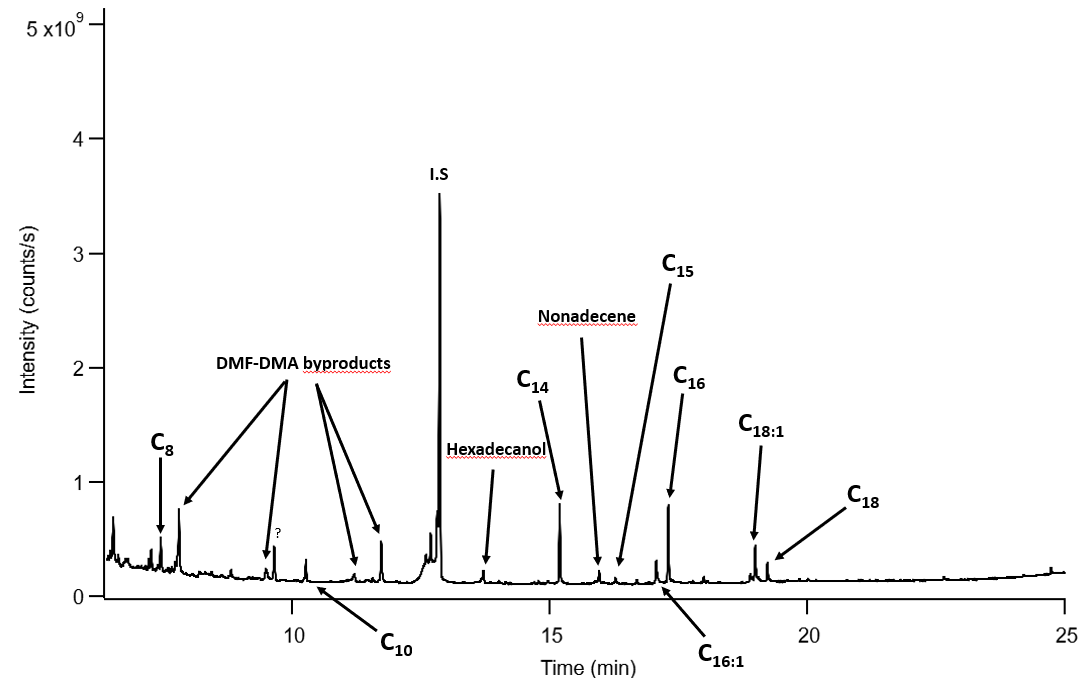- 1LATMOS-IPSL, UVSQ Université Paris Saclay, CNRS, Guyancourt, France
- 2Laboratoire de génie des Procédés et Matériaux (LGPM), CentraleSupelec, Gif-sur-vette, France
- 3Centro de Astrobiología (INTA-CSIC), Madrid, Spain
Introduction: Europa and Enceladus, two ocean worlds in our solar system, are targets of high interest for astrobiology in the decades to come. Past space missions (Cassini-Huygens and Galileo) and recent observations with the Hubble Space telescope have revealed the presence of salts (sulfate and/or chloride) in the plumes of Enceladus and in the components of Europa’s surface (1-4). These salts could interfere in the in-situ chemical analyses of organic molecules present in the collected samples, thus limiting the chance to detect potential biosignatures in these worlds. In order to study this potential analytical interference, terrestrial analog samples to the ocean of Europa and Enceladus were characterized with gas chromatography mass spectrometry (GC-MS) and the associated pretreatment techniques (pyrolysis, derivatization and thermochemolysis) currently used for in-situ analyses of extraterrestrial environments.
Analog samples: Tirez lacustrine system is located in La Mancha, Spain. The samples studied in this work were collected from seven salty lakes in 2019. They are in liquid state and characterized by a high concentration of Mg, Na, SO4 and Cl. These samples are of particular interest for oceans worlds because of spectra obtained from Fourier transform infrared technique were similar to the Galileo spectral data for Europa (5). In addition, micro-organisms from the three domains (bacteria, archaea, eukaryotes) were identified in Tirez lake materials (6).
Among the numerous samples collected during the field trip, this work focused on ten of them for time of investigations.
Results: Thanks to the pretreatment techniques associated to GC-MS, numerous molecules were identified. For instance, with derivatization (dimethylformamide dimethyl acetal) all the components from triglycerides were detected such as fatty acids (Figure) and glycerol. For some sample among the ten selected, phytol coming from the degradation of chlorophyll present in cyanobacteria was also detected. In addition, pyrolysis at different temperatures revealed the presence of furan derivatives, as well as phenol derivatives and naphthalene ones. For the two first, these come from the thermal degradation of carbonates and peptides respectively. In spite of the presence of salts, these few results show that we can identify molecules coming from the living with the usual analytical techniques used for space exploration.

Figure: Chromatogram of a derivatized sample (from Lillo Lake) with DMF-DMA after evaporation of the water. I.S.: internal standard.
Perspectives: Numerous compounds from micro-organisms were not detected such as amino acids or nitrogenous bases. In the near future, we want to try to desalinate these samples in order to identified more organic biosignatures. In addition, specific extraction will be made, particularly for amino acids, in order to characterize their content and confirm or deny that the salts prevent their detection.
References: (1) T. B. McCord, Hydrated salt minerals on Europa's surface from the Galileo near-infrared mapping spectrometer investigation. Journal of Geophysical Research 104, (1999). (2) Waite, Cassini Ion and Neutral Mass Spectrometer Enceladus Plume composition and Structure. Science 311, (2006). (3) S. K. Trumbo, M. E. Brown, K. P. Hand, Sodium chloride on the surface of Europa. Science Advances 5, eaaw7123 (2019). (4) S. K. Trumbo, et al., A New UV Spectral Feature on Europa: Confirmation of NaCl in Leading-hemisphere Chaos Terrain. (2022). (5) O. Prieto-Ballesteros, Tírez Lake as a Terrestrial Analog of Europa. (2003). (6) L. Montoya et al., Microbial community composition of Tirez lagoon (Spain), a highly sulfated athalassohaline environment. Aquatic Biosystems 9, 19 (2013).
How to cite: Moulay, V., Freissinet, C., Buch, A., Gomez Gomez, F., and Szopa, C.: Future in-situ chemical analysis on Europa and Enceladus: impact of salts on the detection of organic compounds in samples from hypersaline Tirez lake (La Mancha, Spain) with GC-MS., Europlanet Science Congress 2022, Granada, Spain, 18–23 Sep 2022, EPSC2022-794, https://doi.org/10.5194/epsc2022-794, 2022.

